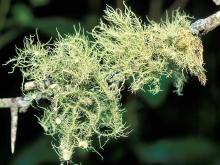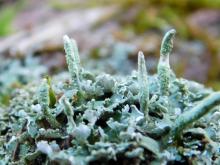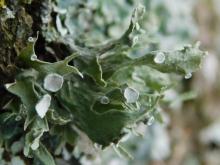Mosses, Liverworts, and Lichens
Media

Species Types
Scientific Name
Usnea spp.
Description
Beard lichens are shrubby, branching, hairy-looking lichens that grow in tufts from a single point on tree branches. They are grayish green, and the branches are round in cross-section.
Media

Species Types
Scientific Name
Cladonia coniocraea
Description
Common powderhorn’s slender, gray-green, hornlike fruiting structures emerge from a carpet of gray-green, scalelike squamules. This lichen usually grows on old, damp wood, often on tree bases, in shady areas.
Media

Species Types
Scientific Name
Ramalina spp.
Description
Twig lichens, or ramalina lichens, are branching, shrubby lichens that grow in tufts from a single point. They are grayish green, and the branches are distinctively flattened.
Media

Species Types
Scientific Name
Flavoparmelia caperata
Description
The common greenshield lichen is a medium to large, green foliose lichen. Common and widespread in eastern North America, it grows on tree bark.
Media

Species Types
Scientific Name
Flavoparmelia baltimorensis
Description
The rock greenshield lichen is a medium to large, green foliose lichen. Common and widespread, it grows on rocks and is especially characteristic of dry, igneous woodlands.
Media

Species Types
Scientific Name
Parmotrema spp.
Description
Ruffle lichens are rather large, broad-lobed foliose lichens that are loosely attached to the substrate. The rounded edges of the lobes usually lift up and look ruffled. Hairlike cilia arise from the lobe edges. They usually grow on tree bark.
Media

Species Types
Scientific Name
Candelaria spp.
Description
Candleflame lichens (Candelaria spp.) are tiny to small, greenish-yellow foliose lichens that grow in a branching, rosette form. Missouri species typically live on tree trunks.
Media

Species Types
Scientific Name
Xanthoria spp. (also Xanthomendoza; Polycauliona)
Description
Orange sunburst lichens are orange or yellow orange. They have a circular, foliose growth pattern with tiny, branching lobes, but this pattern is often lost when these lichens form masses of tiny scale-like fragments. They can be very common on sunny rocks and tombstones.
Media

Species Types
Scientific Name
About 436 species in Missouri
Description
A lichen is a composite organism formed by certain fungus species that join with certain algae species. Lichens can be many colors and can be crusty, leaflike, flaky, branching, or mossy. They grow on rocks, trees, or other surfaces.
Media

Species Types
Scientific Name
Lepraria spp.
Description
Dust lichens resemble a pale green or gray mass of dust clumped at the damp base of a tree trunk or in a rocky crevice. The dusty grains are tiny packages of lichen that can be moved away to make new lichens elsewhere.
See Also
About Mosses, Liverworts, and Lichens in Missouri
Mosses, liverworts, hornworts, and lichens seem rather similar, but these organisms are in very different groups. Mosses, liverworts, and hornworts are small, low plants usually found in damp habitats. Unlike more familiar plants, they lack veinlike structures and do not produce flowers or seeds — instead, they produce spores. Meanwhile, lichens are not plants at all: they are a collection of different fungi that have photosynthetic algae living within their tissues.





















